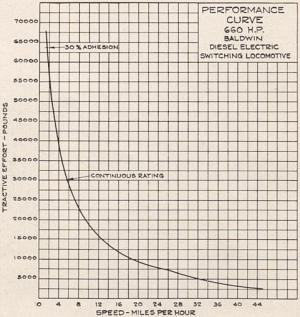pad is inserted between the sub-base and the
main underframe to provide protection against
rail shock.
The De La Vergne Engine
The locomotive is powered with a De La
Vergne Model "VO," four-cycle, six-cylinder
solid injection, cold starting, full diesel engine
direct connected with the main and auxiliary
generators. It has a cylinder bore of 12 1/2
inches, a piston stroke of 15 1/2 inches and is
rated at 660 b.hp. at 600 r.p.m.
This modern De La Vergne design is backed
by the experience gained in forty years of
building solid injection oil engines and twenty
years of building solid injection diesel engines.
De La Vergne's association with oil engines
dates back to the year 1893, when this com-
pany obtained the sole American rights to man-
ufacture the English Hornsby-Ackroyd engine.
The first solid injection diesel engine produced
in the United States was built by De La Vergne
in 1917.
The engine of locomotive 62000 is unique in
that it contains a number of features which are
new in railroad diesel practice, features which
have definite advantages in operation and
maintenance, resulting in lower costs and in-
creased profits.
An exclusive De La Vergne feature of major
importance is the spherically shaped combus-
tion chamber which is cast integral with the
cylinder head and is connected with the cyl-
inder combustion space by a throat.
The contour of the chamber and throat are
such that air, rushing in from the cylinder dur-
ing the compression stroke, creates a turbu-
lence which is controlled in such a way that
the air is thoroughly mixed with the atomized
fuel. This thorough mixing results in a rel-
atively slow sustained combustion period so
|
more important of which may be summarized
as follows:
1.It permits a longer injection period than is pos-
sible in other locomotive diesel engines of
similar size, resulting in low fuel injector
opening pressures and low fuel injection
pressures. The injection pressure of the De
La Vergne engine is about 3300 pounds as
compared with a direct injection pressure of
6000 pounds or more found iť other types.
The De La Vergne firing pressure is about
650 pounds, a distinct gain over other types
where pressures range from 730 to 1000
pounds.
2. The orifices of the multiple spray nozzle can be
made unusually large, thus minimizing the
tendency to clog. Larger openings combined
with lower injection pressure and the conse-
quent lower velocity of the oil, give greatly
reduced erosive action at the nozzle.

Tractive Force Curve for Speeds Up to
45 Miles Per Hour.
|